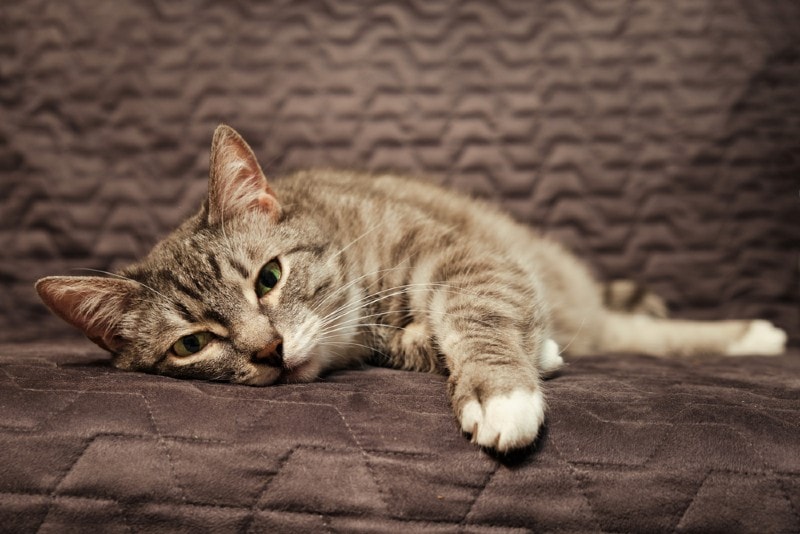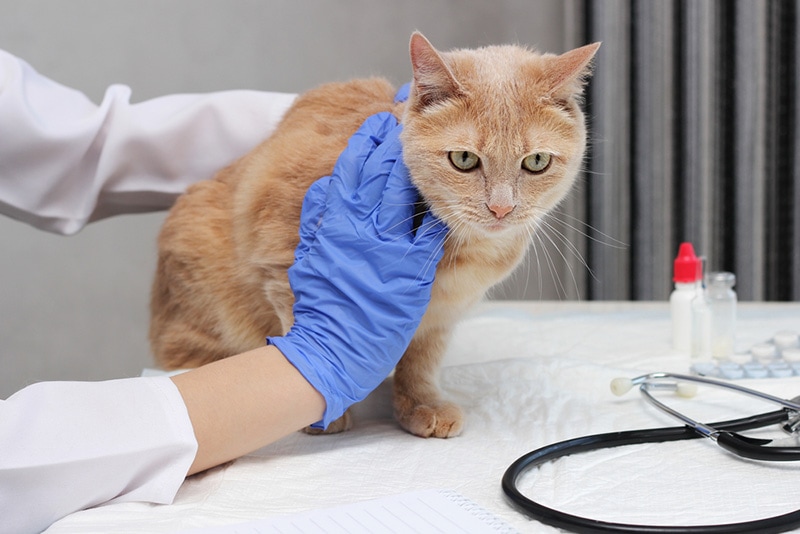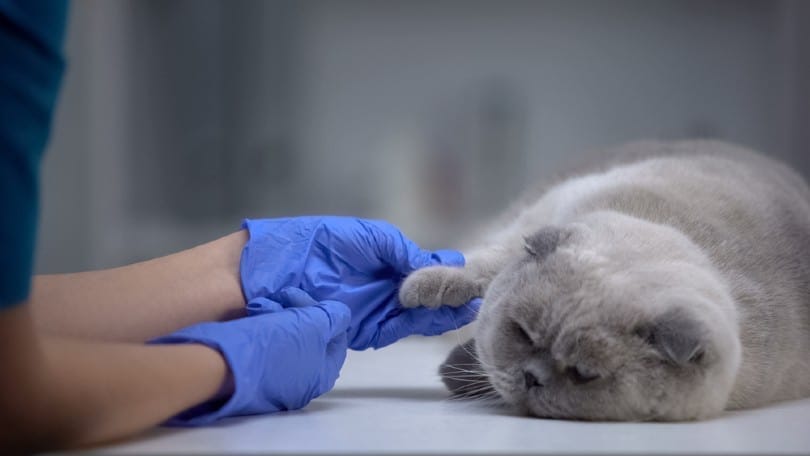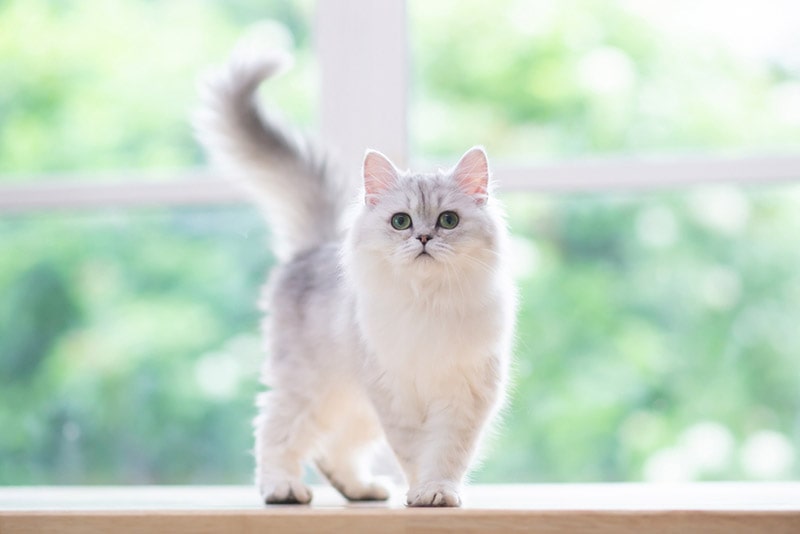
Owning a pet can bring with it all sorts of wondrous experiences, but it also drives home a terrifying point: So much of this world seems specifically designed to kill your beloved animal.
That’s the case with lilies, anyway. These flowers are gorgeous and uplifting, but if you have them in or around your house, you’ll need to make sure that your cat doesn’t get close to them because they’re incredibly toxic to cats. All parts of the plant are highly poisonous. In fact, even a single lick or a nibble of a lily plant, licking some pollen off their coat, or drinking from a vase with lilies in it can kill your cat.
To learn more about why these plants are so deadly and what to do to make sure your cat never has a run-in with a lily, read on.
Can Cats Eat Lilies?
Definitely not! There are many plants with the name “lily” in them, but they’re not all equally toxic. The most dangerous and potentially life-threatening are plants that belong to two genus of lily plants: Lilium (true lilies) and Hemerocallis (day lilies). All plants in these groups are toxic and should be avoided at all costs.
Don’t think that there are certain parts of the plant that are safe. The entire plant is toxic, including the stem, leaves, flowers, and pollen. In fact, lilies are so deadly that your cat can die if they simply drink the water that’s in the plant’s vase.
For some reason, cats are the only known species that are affected so seriously by lilies. Dogs shouldn’t eat them either, but the worst that’s likely to happen to your pooch is that they’ll get digestive upset. Your cat, on the other hand, can die — and quickly.
It’s also worth noting that some plants are commonly called lilies but aren’t actually “true” lilies. Some of these — like lilies of the valley and flame lilies — are just as deadly, but they contain different toxins.
There are also some “fake” lilies, like calla lilies and peace lilies, that aren’t as deadly to cats, but they can still cause issues for your cat. These issues include irritation of the mouth and throat, diarrhea, vomiting, and breathing problems.

What Happens to a Cat That Eats Lilies?
The toxin inside lilies affects a cat’s kidneys, and it does so aggressively. In fact, a cat can develop acute renal failure in as little as 24 hours of having contact with the toxin.
Never wait to see if your cat develops signs of illness. Take your cat to the nearest emergency clinic if you suspect your cat had any form of contact with lilies. These are the possible initial signs your cat could be exhibiting it they get poisoned:

After about 12 hours, you may also notice increased urination and dehydration followed by lack of urine production and death. These are signs that acute kidney damage has occurred.
It should also be noted that not all cats react to lily poisoning the same way. All cats will experience kidney problems and all need prompt treatment, but some seem to recover quicker than others. The prognosis for recovery is time dependent, so do not wait to see if your cat shows signs of illness, as it may then be too late.
What Should I Do If My Cat Has Come in Contact With a Lily?
The most important thing to do is act quickly. You literally have minutes to contact your vet and take your cat to the clinic. Remember that the entire lily is toxic, so even if you didn’t see your cat ingest any of the plant, they still may get poisoned from the pollen. Wipe your cat’s face with a warm cloth to remove as much of the pollen as possible, then look for any evidence that the lily has been chewed on.
After doing that, it’s time to head to your vet’s office. You can take a picture of the plant if in doubt, but it’s better not to take the plant with you if you can. Knowing the type of lily will help your vet make a diagnosis and figure out the best treatment plan.
Call ahead to let your vet know that you’re coming. This can allow them to prepare for your arrival, including clearing out less-urgent patients if necessary and collecting all the necessary supplies for treating your cat.

How Is Lily Toxicity Treated in Cats?
Depending on your cat’s health situation, if you manage to get your cat to the vet early enough, they may try to empty their stomach, administer activated charcoal to soak up any toxins that may be lingering in their stomach, and wash any remaining pollen off them. They will also get your cat on a drip to administer intravenous (IV) fluid therapy.
IV treatment will likely be started because your cat’s kidneys will need plenty of fluid to support their function and prevent them from becoming damaged. This will also help flush the toxin out of your kitty’s system. Their urine output will be closely monitored, as this is one of the most important indicators of how your cat is faring.
If you weren’t able to get your cat to the vet immediately and the poisoning has progressed to an advanced stage, dialysis may be required to keep the kidneys functioning. Dialysis may be needed for a few days or even longer, although in many of those cases, the prognosis is grim enough that euthanasia will likely be recommended.

What Is the Prognosis for a Cat Suffering From Lily Toxicity?
This is a hard question to answer. It depends on how much toxin your cat ingested and how long it took to get them treatment. Also, some cats seem to recover quicker and more completely than others.
If you get your cat to a vet promptly, your cat has better odds. After about 18 hours, though, the kidney damage will likely be irreversible.
Even cats that can survive after the first 18 hours may have a hard road ahead of them. It is possible that your cat develops long-term kidney damage. Your veterinarian will advise you on the frequency of check-ups and long-term treatment to ensure that any kidney problems are detected early.
How Do I Prevent Lily Poisoning in My Cat?
The best and easiest way to prevent your cat from experiencing lily toxicity is to simply never let them come near the plants and avoid having any contact with a lily yourself so as not to bring pollen home. Don’t plant them in your garden and don’t bring them into your home.
You won’t have control over whether other people plant lilies, of course, but you can ensure that your cat won’t come in contact with your neighbor’s lilies by keeping them indoors. This is just good for your cat in general, even not taking into account potential lily exposure — indoor cats live much longer on average than outdoor ones do.
Even if you keep your cat indoors at all times, you still shouldn’t plant lilies if you care about the neighborhood cats.
Don’t think that you can bring lilies into your house and keep your cat safe by putting them out of your cat’s reach either. Remember, the pollen is just as deadly as the rest of the plant, so if that happens to blow onto your cat, you could kill them just as surely as if you let them gnaw on the leaves.

What’s the Verdict? Are Lilies Toxic to Cats?
Lilies are among the most toxic plants to cats on Earth, and you should do everything in your power to ensure that your cat never comes in contact with one. Every part of the plant is deadly to cats, so you shouldn’t let your cat anywhere near one of these flowers.
If your cat does happen to encounter a lily, time is of the essence. Rush them to the vet immediately, as their chances of survival drop precipitously after 18 hours.
See also:
- Are ZZ Plants (Zamioculcas Zamiifolia) Toxic to Cats?
- Are Jade Plants Toxic To Cats? What You Need To Know!
Featured Image Credit: Jacqueline VERIN, Pixabay







